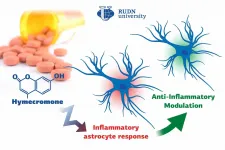Measuring the tRNA world
Researchers have developed a method to quantify transfer RNAs
2021-02-26
(Press-News.org) Transfer RNAs (tRNAs) deliver specific amino acids to ribosomes during translation of messenger RNA into proteins. The abundance of tRNAs can therefore have a profound impact on cell physiology, but measuring the amount of each tRNA in cells has been limited by technical challenges. Researchers at the Max Planck Institute of Biochemistry have now overcome these limitations with mim-tRNAseq, a method that can be used to quantify tRNAs in any organism and will help improve our understanding of tRNA regulation in health and disease.
A cell contains several hundred thousand tRNA molecules, each of which consists of only 70 to 90 nucleotides folded into a cloverleaf-like pattern. At one end, tRNAs carry one of the twenty amino acids that serve as protein building blocks, while the opposite end pairs with the codon specifying this amino acid in messenger RNA during translation. Although there are only 61 codons for the twenty amino acids, cells from different organisms can contain hundreds of unique tRNA molecules, some of which differ from each other by only a single nucleotide. Many nucleotides in tRNAs are also decorated with chemical modifications, which help tRNAs fold or bind the correct codon.
The levels of individual tRNAs are dynamically regulated in different tissues and during development, and tRNA defects are linked to neurogical diseases and cancer. The molecular origins of these links remain unclear, because quantifying the abundance and modifications of tRNAs in cells has long remained a challenge. The team of Danny Nedialkova at the MPI of Biochemistry has now developed mim-tRNAseq, a method that accurately measures the abundance and modification status of different tRNAs in cells.
Modification roadblocks and resolutions
To measure the levels of multiple RNAs simultaneously, scientists use an enzyme called reverse transcriptase to first rewrite RNA into DNA. Millions of these DNA copies can then be quantified in parallel by high-throughput sequencing. Rewriting tRNAs into DNA has been tremendously hard since many tRNA modifications block the reverse transcriptase, causing it to stop synthesizing DNA.
"Many researches have proposed elegant solutions to this problem, but all of them relieve only a fraction of the modification roadblocks in tRNAs", explains Danny Nedialkova, Max Planck Research Group Leader at the Max Planck Institute of Biochemistry. "We noticed that one specific reverse transcriptase seemed to be much better at reading through modified tRNA sites. By optimizing the reaction conditions, we could significantly improve the enzyme's efficiency, enabling it to read through nearly all tRNA modification roadblocks", adds Nedialkova. This made it possible to construct DNA libraries from full-length tRNA copies and use them for high-throughput sequencing.
The mim-tRNAseq computational toolkit
The analysis of the resulting sequencing data also presented significant challenges. "We identified two major issues: the first one is the extensive sequence similarity between different tRNA transcripts", explains Andrew Behrens, PhD student in Nedialkova's group and first author of the paper. "The second one comes from the fact that an incorrect nucleotide (a misincorporation) is introduced at many modified sites during reverse transcription. Both make it extremely challenging to assign each DNA read to the tRNA molecule it originated from", adds Behrens.
The team tackled these issues with novel computational approaches, including the use of modification annotation to guide accurate read alignment. The resulting comprehensive toolkit is packaged into a freely available pipeline for alignment, analysis and visualization of tRNA-derived sequencing data . Researchers can use mim-tRNAseq to not only measure tRNA abundance, but also to map and quantify tRNA modifications that induce nucleotide misincorporations by the reverse transcriptase. "mim-tRNAseq opens up myriad possibilities moving forward," says Nedialkova. "We expect it will help us and others to tackle many outstanding questions about tRNA biology in health and disease."
INFORMATION:
Original publication
A. Behrens, G. Rodschinka, D.D. Nedialkova
High-resolution quantitative profiling of tRNA abundance and modification status in eukaryotes by mim-tRNAseq
Molecular Cell, February 2021
ELSE PRESS RELEASES FROM THIS DATE:
2021-02-26
What The Study Did: Researchers investigated whether home addresses recorded in the electronic medical record could be used to accurately estimate transmission risk of SARS-CoV-2 and identify risk factors for transmission.
Authors: Joshua P. Metlay, M.D., Ph.D., of Massachusetts General Hospital in Boston, is the corresponding author.
To access the embargoed study: Visit our For The Media website at this link https://media.jamanetwork.com/
(doi:10.1001/jamanetworkopen.2021.0304)
Editor's Note: Please see the article for additional information, including other authors, author contributions and affiliations, conflict of interest and financial ...
2021-02-26
What The Study Did: Researchers in this observational study assess at what age young people ages 12 to 17 start using cigarettes.
Authors: Adriana Pérez, Ph.D., of the University of Texas Health Science Center at Houston in Austin, is the corresponding author.
To access the embargoed study: Visit our For The Media website at this link https://media.jamanetwork.com/
(doi:10.1001/jamanetworkopen.2021.0218)
Editor's Note: The article includes conflicts of interest and funding/support disclosures. Please see the article for additional information, including other authors, author contributions and affiliations, conflict of interest and financial disclosures, and funding and support.
INFORMATION:
Media advisory: The full study is linked to ...
2021-02-26
PHILADELPHIA-- Even though the use of rhythm control strategies for treating Paroxysmal Atrial Fibrillation (AF), a common abnormal heart rhythm, have increased overall in the United States, patients from racial and ethnic minority groups and those with lower income were less likely to receive rhythm control treatment - often the preferred treatment - according to new research from the Perelman School of Medicine at the University of Pennsylvania. The study is published in the JAMA Network Open.
"Research has demonstrated the pervasive impact of structural racism on health outcomes among minoritized patients. We know, for instance, that there is less use of novel cardiovascular therapies among Black, Latinx, and patients of lower socioeconomic ...
2021-02-26
A Mason Engineering researcher has discovered that artificial microswimmers accumulate where their speed is minimized, an idea that could have implications for improving the efficacy of targeted cancer therapy.
Jeff Moran, an assistant professor of mechanical engineering in the Volgenau School of Engineering, and colleagues from the University of Washington in Seattle studied self-propelled half-platinum/half-gold rods that "swim" in water using hydrogen peroxide as a fuel. The more peroxide there is, the faster the swimming; without peroxide in pure water, the rods don't swim.
In this work, they set out to understand ...
2021-02-26
People living with obesity tend to have unhealthy glucose and lipid levels in their blood, as well as high blood pressure. As a result, they are more at risk of cardiovascular and metabolic diseases. But scientists have observed that up to 45% of people living with obesity have healthy blood pressure and glucose and lipid levels, and therefore may not be at high risk of disease. The reason why this group of people with obesity remain healthy, has been poorly understood.
But now a team of researchers - led by scientists at the University of Copenhagen and Icahn School of Medicine ...
2021-02-26
Biologists from RUDN University confirmed that a well-known spasmolytic drug called hymecromone can suppress the inflammatory response in astrocytes, important glial cells of the central nervous system. Potentially, it could be used to develop medications against Alzheimer's disease and other neurodegenerative conditions. The results of the study were published in the International Journal of Molecular Sciences.
All pathological processes in the nervous system, such as neurodegenerative diseases, injuries, or intoxications, are associated with inflammations. ...
2021-02-26
An insecticide used to control pest infestations on squash and pumpkins significantly hinders the reproduction of ground-nesting bees -- valuable pollinators for many food crops, a new University of Guelph study has revealed.
This first-ever study of pesticide impacts on a ground-nesting bee in a real-world context found female hoary squash bees exposed to imidacloprid dug 85 per cent fewer nests, collected less pollen from crop flowers and produced 89 per cent fewer offspring than unexposed bees.
"Because they're not making nests and not collecting pollen, they cannot raise offspring," said Dr. Susan Willis Chan, a post-doc in the School of ...
2021-02-26
Heart problems cause disturbed gene activity in the brain's memory center, from which cognitive deficits arise. Researchers at the German Center for Neurodegenerative Diseases (DZNE), the University Medical Center Göttingen (UMG) and the German Center for Cardiovascular Research (DZHK) come to this conclusion based on laboratory studies. They consider that they have found a possible cause for the increased risk of dementia in people with heart problems. In mice, a specific drug which is known to affect gene activity alleviated the mental deficits. The involved experts see these results as potential approaches for therapies. ...
2021-02-26
HOUSTON - (Feb. 26, 2021) - Tracking the origin of synthetic genetic code has never been simple, but it can be done through bioinformatic or, increasingly, deep learning computational approaches.
Though the latter gets the lion's share of attention, new research by computer scientist Todd Treangen of Rice University's Brown School of Engineering is focused on whether sequence alignment and pan-genome-based methods can outperform recent deep learning approaches in this area.
"This is, in a sense, against the grain given that deep learning approaches have recently outperformed traditional approaches, such as BLAST," he said. "My goal with this study is to start a conversation about how to combine the expertise of both domains to achieve further improvements for this important computational ...
2021-02-26
TORONTO, Feb. 26, 2021 - The maternal care of offspring is one of the behavioural drivers that has led some bee species to have an ever-expanding social life over the history of evolution, new research out of York University has found.
By virtue of being in a social group, the genome itself may respond by selecting more social rather than non-social genes. The behaviour and social environment come first, setting the stage for future molecular evolution.
In addition, the researchers have found that a similar genetic evolution happened independently in different species at different times, suggesting there is a unifying principle leading to the same social trait.
"There seems to be something about sociality specifically that is driving the genome to evolve in this way. It's a very ...
LAST 30 PRESS RELEASES:
[Press-News.org] Measuring the tRNA world
Researchers have developed a method to quantify transfer RNAs




